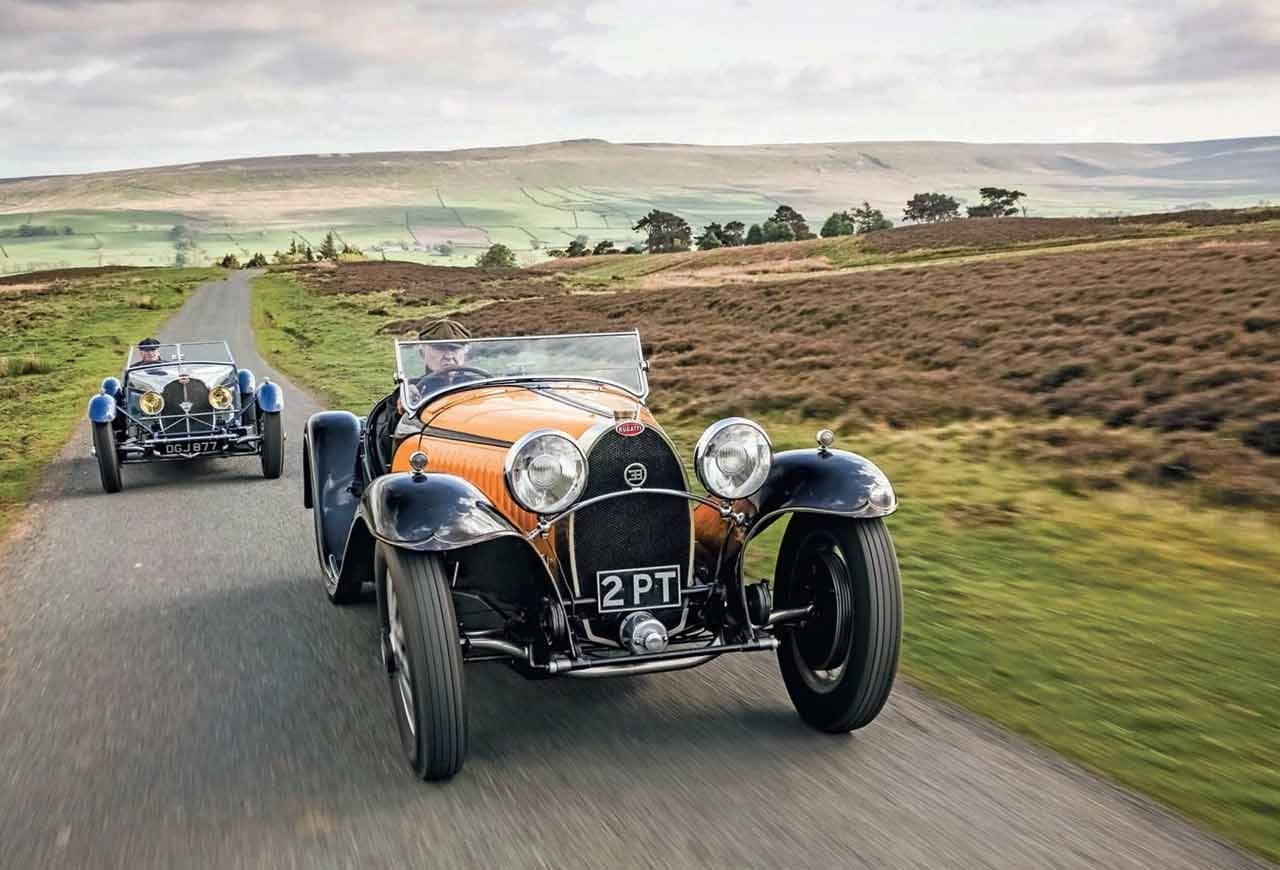
A passion for Bugatti Mick Walsh meets Neil Corner and his Molsheim marvels: Type 55 and T57S. Bugatti’s greatest road cars. Molsheim’s Grand Prix glory faded in the 1930s but its sports cars shone, as this intriguingly linked T55 and T57S prove. Words Mick Walsh. Photography Tony Baker.
BUGATTI’S BEST ROAD CARS HEAD-TO-HEAD
The rugged moorland roads of North Yorkshire can reveal epic views, but the fantastic sight of these two pre-war Bugatti sports cars rivals the area’s undeniable natural beauty. To see one Molsheim marvel on the open road is very rare today, but to witness the glorious sight of a Type 55 roadster followed by a sleek Type 57S, accompanied by the exotic sound of two twin-cam straight-eights, is a magical moment.
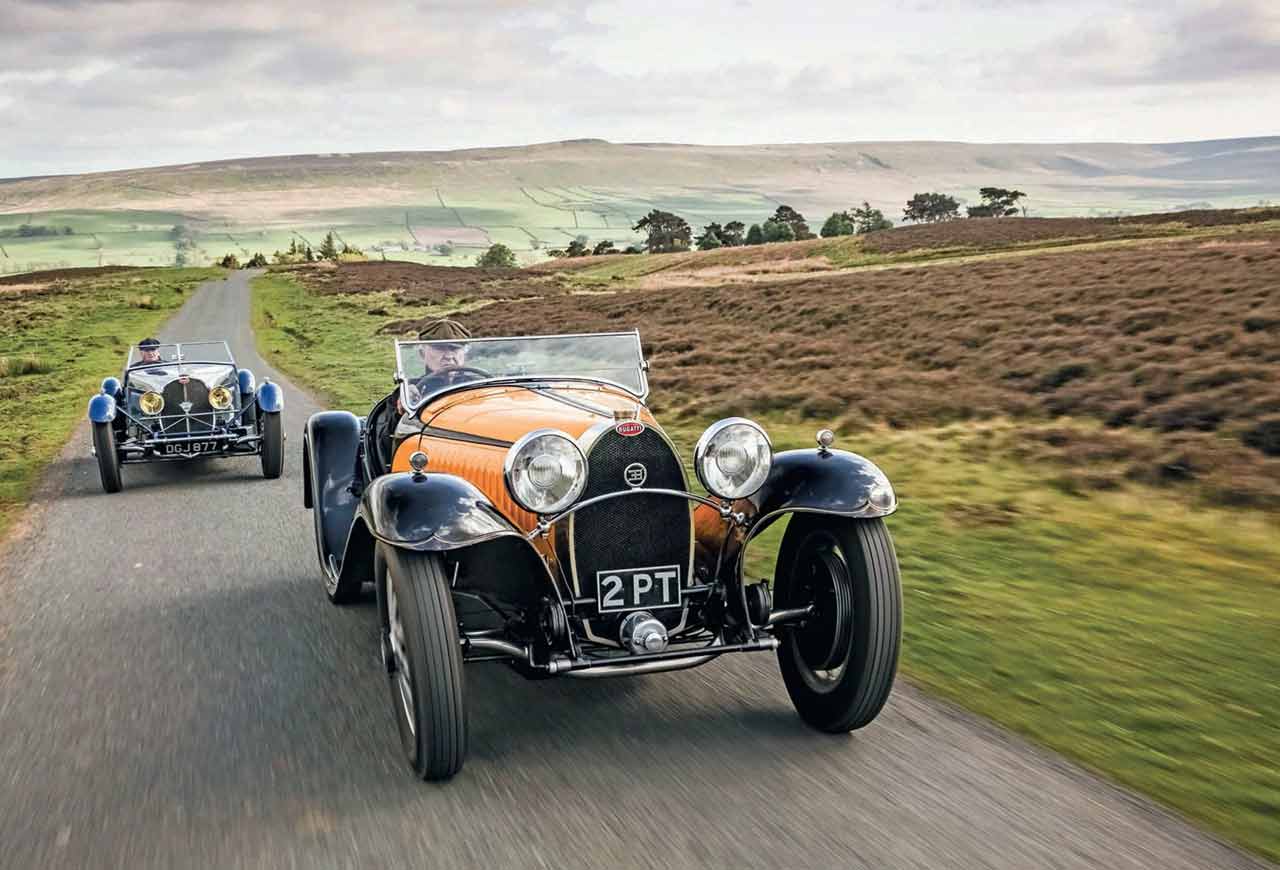
As they dart over deserted passes against the backdrop of Great Haw, the Type 55 with its flowing lines and Art Deco-style yellow-and-black paintwork contrasts dramatically with the low-slung, long-bonneted blue roadster behind. Amazingly, the two designs are just four years apart, the Type 55 a factory-formed beauty while the later Type 57S was sold as a chassis, bodied by English coachbuilder Corsica and continually refined by a long-term second owner.
Both are performance legends capable of over 100mph. The T55 is powered by a supercharged 2.3-litre Type 51 Grand Prix engine with roller-bearing crank, while the later plain-bearing, naturally aspirated 3.2-litre Type 57S punches out mighty torque and close to 200bhp.
Both are in fabulous fettle after being in the long-term ownership of Neil Corner, a hugely respected enthusiast who has owned and raced many of the greatest historic cars. A lifelong Bugatti fan, he and his equally knowledgeable wife Freda share the belief that cars are meant to be driven, and they’ve covered high mileages in both Bugattis, which remain favourites in their collection. Bentley Blower, Alfa 8C and Ferrari 250s have come and gone, but the two Bugattis have remained a constant, which says a lot about the allure of Molsheim’s finest.
The two cars make a fascinating comparison, both stylistically and in terms of their specification. The T55 was born from spare Type 51 engines, Bugatti’s last dominant Grand Prix contender, fitted into a Type 47 chassis with a Type 49 gearbox. Of the 38 built, just 13 were fitted with factory roadster bodywork, which many think makes it the most beautiful Bugatti road car of all. With its solid, attractively forged axles, leaf springs and signature GP-style cast-alloy wheels, it masterfully combines the design of both Bugatti generations because Ettore’s son Jean was instrumental in the introduction of its twin-cam engine and styled its wonderful shape.
The Type 57S was the swansong of Bugatti’s glorious road cars. With an axle passing through the rear frame, its distinctive vee radiator and a dry sump, the Corsica roadster has a much lower stance. Even with English-built bodywork and riding on Rudge wire wheels, it still looks every inch a Butatti thoroughbred. Created as a light roadster to race, with minimal chrome, this bespoke machine has a purposeful presence that contrasts with the flamboyant T55. In famous streamlined ‘Tank’ form, the unsupercharged Type 57G took double Le Mans victories while the T55’s racing record was inglorious, but both represent ultimate road cars of the 1930s.
Corner purchased the Type 55 first, and since 1970 few have driven one so consistently – but then no car stays long in his collection unless it delivers from behind the wheel. “I’d been racing my Type 35B and the car won everything, setting lap records everywhere,” enthuses Corner. “In the wet it was fantastic. From the Grand Prix car, my wife Freda and I became fascinated by the Bugatti family.

“I knew little about Type 55s but loved the bodywork. At Silverstone in 1965 I was standing with my great friend Geoffrey St John on the pit wall watching sports cars practice and a Type 55 went past smoking badly. Geoffrey remarked that I should buy it. A few years later, Dick Crosthwaite called to say the owner wasn’t keen to repair the engine, and now was a good time to make an offer.” Corner did a deal and the T55 travelled to Yorkshire aboard the Ecurie Ecosse transporter together with a Grand Prix Type 59. This Type 55, chassis 55207, started out with factory-built coupé styling that was swapped just after WW2 for a genuine roadster body from chassis 55223, the 1933 London Motor Show car, which was bought off the Bugatti stand by NS ‘Nicky’ Embiricos.
Arthur Birchall, a brilliant ex-Team Lotus mechanic who worked with Jim Clark, had joined Corner’s team and set about restoring the T55. Crosthwaite & Gardiner rebuilt the engine around a new lower crankcase. Tuning included an original Zenith 48K carburettor and Type 51 firing order: “The Type 51 engine is the best that Bugatti built, and this has proved unbreakable. We change the oil every year and have never had a problem with crankshaft or roller bearings.”
The only major change was to the gearbox, because the T55 had already been converted to an ENV preselector. “The original specification was a T49 transmission, a feature that Bugatti connoisseurs maintain spoils the car due to its slow change, particularly from first to second.”
Working with Brineton Engineering, a new gearbox was built using an original Type 49 casing, but with constant-mesh internals. “It’s now the fastest change of any pre-war car I’ve driven,” says Corner. “You just want to change up and down for the joy of it. We’ve also fitted an overdrive for long-distance tours.”
Once Birchall had finished the mechanical restoration, the body was repainted the classic black-and-yellow scheme that perfectly sets off the Jean Bugatti styling. Then Corner set out to fine-tune the handling: “We sorted the initial understeer by running 40lb tyre pressures, and the brakes cope better with the extra weight of the body when they are adjusted well up.”

Since the restoration’s completion, the Corners have driven the Type 55 extensively. Only St John’s much-travelled, Figoni et Falaschi-bodied T55 rivals the Corners’ car for constant enjoyment and miles covered. As well as regular runs to work across Yorkshire, this fabulous machine has toured all over Europe including trips to Spain, Ireland and back to Molsheim: “We’ve compared its performance to an Alfa 8C Zagato, which was no match for the Type 55’s torque and acceleration on local Yorkshire roads. It’s easy to appreciate why Bugattis have always dominated the Williams Trophy around Cadwell Park.”
The T57S, coincidently, also has connections with the fabulously wealthy Embiricos. To replace his T55, the 26-year-old bought the very car featured here. The first Type 57S in England, chassis 57.375 was ordered through the London agent Colonel Sorel. Originally, the instruction was for the exotic Aero coupé, but this was switched to a chassis-only build. A keen privateer racer, Embiricos had seen some success with his ERA R2A, including a third place at Monaco.
A plan to run the new Bugatti in the Tourist Trophy at Ards on 5 September 1936 left little time for Corsica to complete the bodywork when the chassis was finally delivered from France in late August. Story has it that the talented north London coachbuilder took just four days to make the body, the styling combining the efforts of Embiricos, John Lee and Charlie Stammers. Corsica eventually bodied eight Type 57S models and the firm boasted an impressive client list that was a Who’s Who of British sporting motorists, including Land Speed Record legend Sir Malcolm Campbell.
To compete with the Gallic Delahaye and Talbot rivals, Embiricos instructed that the new Bugatti body be as light as possible. The finished car, painted pale grey with a Greek flag on the long, low bonnet, was a sleek, purposeful two-seater with cycle wings and a bobbed tail that was shaped to a point around the petrol tank. Racy features included aeroscreens, an external oil tank behind the front-left wheel, and four exhausts exiting dramatically together.
The new car, registered DGJ 877, didn’t arrive in Ards until the Thursday ahead of the Saturday race, but its sleek lines and stylish veeshaped radiator were the talk of the paddock.
Embiricos was the first private owner to build a sports-racer from the glamorous 57S. With little time to test the new car, he struggled in the event, particularly when wet weather made the challenging road circuit very slippery. And the Bugatti faced a strong over-3-litre class of 10 cars, as well as three ‘works’ BMW 328s in the handicap event. The press reported that the new Bugatti ‘looked and sounded marvellous’, but appeared to be a ‘trifle wavy at the back’ through its descent into Bradshaw’s Brae, suggesting that the rear was a little light with low fuel.
The weather was grim and Embiricos soon had the works Delahayes hounding him on the run into Newtownards on the second lap. An impatient Marcel Mongin muscled past the Bugatti through the town, but lost his Delahaye under braking and had to do it all again. Over the notorious bump before Comber the Delahaye caught the Bugatti but they tangled wheels, resulting in a spectacular crash as both drivers veered off the track. The Delahaye fared worse, rolling across a field and throwing out its driver; Mongin landed under a cow, badly shaken and with a broken arm. Both retired.
The bent Bugatti was sent back to London for Giulio Ramponi to rebuild for Richard Seaman to race. Embiricos’ racing career ended in 1937 when he crashed his ERA, newly fitted with Tecnauto independent suspension, in practice for the GP di Firenze. Although not seriously injured, the Greek playboy gave up motorsport and sold his race cars, including chassis 57.375.
However, Embiricos’ lifestyle remained in top gear with a new Type 57C Atalante road car and a social set that included Josephine Baker. Later, in America, Embiricos became fixated by Eleanor Young, the Manhattan glamour girl known as ‘Cookie.’ The lovers died together in 1941 when his Fairchild 24 crashed in poor weather off the coast near Matunuck, Rhode Island.
The second owner of the Type 57S was Ronnie Symondson, a Cambridge graduate who became a respected engineer and flight instructor at Brooklands. From his first Bugatti, a Brescia bought in 1925, the ever-immaculate Symondson was loyal to the marque. After frustrations with the performance of an older Type 57 sports car, which wouldn’t reach the ton, Symondson started looking for a replacement and spotted the ex-Embiricos TT car for sale in Bayswater – Seaman’s plans to race it became difficult due to his commitments with Mercedes- Benz. Initially the price was too high for Symondson, but it eventually dropped far enough to tempt him. A test drive impressed and a deal was done, leaving him sufficient funds to instruct Corsica to sort the bodywork.
It received new wings, a full-width screen and a modified tail, was repainted in blue and had its interior retrimmed and, after tuning courtesy of Thomson & Taylor at Brooklands, the Type 57S proved spectacular. ‘The acceleration was astonishing. The performance was fully up to my expectations which meant that I not infrequently saw 115mph and more on the speedometer,’ recalled Symondson in the club magazine Bugantics. Right away, Symondson started competing with 57.375 including at Prescott in April 1938 and at the Lewes Speed Trials, but war forced a long lay-up. As a chief instructor with the RAF, Symondson rose to Wing Commander and flew a huge range of aircraft.
When peacetime came, the prized Bugatti was brought out of storage and, ever a perfectionist, Symondson sent it back to Thomson & Taylor for a complete rebuild. As racing returned, the Bugatti proved to be one of the fastest sports cars in Britain and at the first Silverstone meeting, Symondson beat Tony Crook in the Mille Miglia-winning Alfa Romeo 8C-2900 Spider. Until the arrival of the Jaguar C-types, the Bugatti was a regular front-runner.
Subtle modifications to lighten the car continued including extensive drilling of hinges, pedals and the handbrake, while even the wood frame was chamfered. Symondson became an expert on the complex De Ram shock absorbers, contacting the manufacturer about special settings and even having his own tools made up by Thomson & Taylor. In 1956, Symondson upgraded the brakes to a hydraulic system. Again carried out by T&T, the conversion retained the original drums but used Lockheed-supplied cylinders and piping. From the mid-’50s, Symondson focused on vintage and Bugatti Owners’ Club events, where he still set the pace in the over-3-litre sports-car classes.
Few were trusted to drive 57.375, but John Bolster talked Symondson into featuring it as an Autosport ‘Yuletide Road Test’. Bolster was hugely impressed by the very sorted car and reported 0-60mph in 7.8 secs on non-original 16in wheels, which were fitted for hillclimbing. ‘The Bugatti must be the envy of every red-blooded enthusiast,’ concluded Bolster who, like many, was almost lost in the lowered passenger seat, his signature deerstalker hat only just visible as Symondson demonstrated the Bugatti’s dramatic acceleration.
During his 45-year ownership, Symondson completed more than 2000 runs at Prescott, the car immaculately presented to match the owner’s sartorial style; a true gentleman, he always competed wearing a sports jacket and tie. “With his impeccable manners and signature cigarette holder, Ronnie oozed style,” recalls Corner. “His favourite women – including my wife Freda – were always called ‘sweetie’. He was also a polished and fast driver.”
Corner’s extensive experience of the finest race and road cars has included many Bugattis, his passion for the marque having started with his T35B. He and his wife have owned several Type 57s including the ex-Campbell 57.531, but he’d always admired Symondson’s car: “Ronnie was one of Ralph Millais’ set and, like me, had raced both the Sunbeam Tiger and Type 59.
After one VSCC Silverstone, he asked if I’d like to drive his 57S back to The Sun at Whitfield. I was nervous as hell but the car blew me away, it was the fastest pre-war road car I’d ever driven. ‘You drove it beautifully but could have changed gear quicker,’ was Ronnie’s remark.”
Later in the summer of 1984, when Symondson was nearing 80, news came via Corner’s great friend St John that the car might be up for sale because Symondson had finally retired from competition: “It was a tricky call. I made him an offer and later Ronnie called back to say he’d be delighted for us to have the car. I went down to Charles Cottage with my son, Nigel, to collect it, and after an excellent lunch we set out for North Yorkshire. We were home in 4 hrs 30 mins, averaging 70mph. I rang Ronnie, and his first question was, ‘Did you pull five-five?’ No, I lifted at 5000 was my answer. ‘Well, that’s still 114mph!’” The Type 57S immediately became Corner’s regular transport to work.
The great Bugatti, always known by the Corner family as ‘Ronnie’s car’, has been fastidiously maintained, always preserving its precious original condition, including the trim. In recent years, the engine has been rebuilt and the bodywork repainted a darker blue. Authentic details have included larger headlights, an original windscreen and 18in wheels. Axles and steering parts have been polished, but other than the chromed vee radiator shell, the car retains its very purposeful poise as desired by Embiricos and Symondson. When Corner fitted his BRDC badge, Freda joked that: “Ronnie wouldn’t approve because it added extra weight!”
To drive these two historic Bugattis back-to- back is a fascinating and highly privileged comparison. The cockpit of the T55 is a novel design. Like in the GP car, you sit upright with feet deep inside the chassis, but with less space because the gearchange is now in the centre.
Under the main wooden instrument panel the engine-turned scuttle is clearly visible.
The engine, with camshaft bevel and spurtrain drive up front, has a busier note, a mechanical score combining engine thrash, rollers and blower whoop that almost drowns out the crisp, hard-edged bark from the exhaust. This engine loves to rev and pulls beautifully, a feature that can be better appreciated with the sensational modified gearbox. The original Touring T49 with its sluggish, heavy change was the curse of this exotic, but Brineton’s design has a fast, short action that has you checking you’ve actually engaged the next gear. With no concerns about noisy, slow changes, the T55 is a fantastic driving machine with a superb ride that Alfa 8C owners can only dream of. Out on the Moors, through clear, open bends, it’s easy to imagine you’re Chiron or Varzi at Monaco or Spa as you relish the sharp steering and lusty power, all enhanced by that rapid change. With the extra weight over the GP cars, the cable-drum brakes demand progressive pressure and experienced feel, because locking up over bumps in the road can twist the axle. It’s a rich, exotic experience that feels 100% pur sang, and passing shop windows there’s nothing to match the reflection of those flowing lines.
The Type 57S is equally impressive, but in a more refined manner. Through the driver’s door (the T55 doesn’t have them), you slide under the same four-spoke, walnut-rimmed steering wheel, but the seating is snug, low and fitted; your eyes are almost level with the long, tapering bonnet. The dashboard has a cutout in the middle to clear the cranked gearlever and the steering column has been shortened to improve the driving position. Symondson was a perfectionist when it came to ergonomics.
Out on the road, thanks to the damping of the complex De Ram shock absorbers, the ride is superb, smoothing out the bumps and retaining firm control when cornering fast. After the slick action of the Brineton ’box, the wide gate and long, hooked lever of the Type 57S feel slow, but Corner advises that I’m too hesitant and the change can be worked quicker.
The performance is staggering for a 1936 design, the dramatic reserves of torque launching it out of turns with Cobra-like punch. It storms effortlessly up gradients, and will power away in top gear from 1000rpm or lower.
The engine’s flexibility is truly outstanding, making it a perfect touring car, ready to munch the miles at an impressive but relaxed pace. Every aspect of this well-sorted machine – balanced handling, mighty performance, inspiring steering and meaty hydraulic brakes – feels brilliantly tuned. It’s easy to appreciate why XK120 drivers had such a tough time with Symondson’s blue wonder.
Both cars are definitive greats in my book and it’s very hard to choose a favourite. The Bugatti purist in me would desire the magnificent Type 55, but the T57S is the ultimate pre-war sports car – little wonder it’s had just three owners in 82 years. The Corner family is split, too, with Neil and Freda saying the T55 would be the last to go, and Nigel choosing ‘Ronnie’s car’. Long may both Bugattis be enjoyed by these passionate enthusiasts.
Thanks to Neil and Freda Corner, and Richard Fox
Photo
‘Every aspect of the Type 57S – balanced handling, inspiring steering and meaty hydraulic brakes – feels brilliantly tuned’
‘The purist in me would desire the magnificent Type 55, but the Type 57S is the ultimate pre-war sports car’
“It’s now the fastest gearchange of any pre-war car I’ve driven. You just want to change up and down for the joy of it”
Top: the yellow and black T55 and blue Type 57S rival the stunning vista. Left: Corner competing in a Bugatti T59 at Oulton Park in 1970.
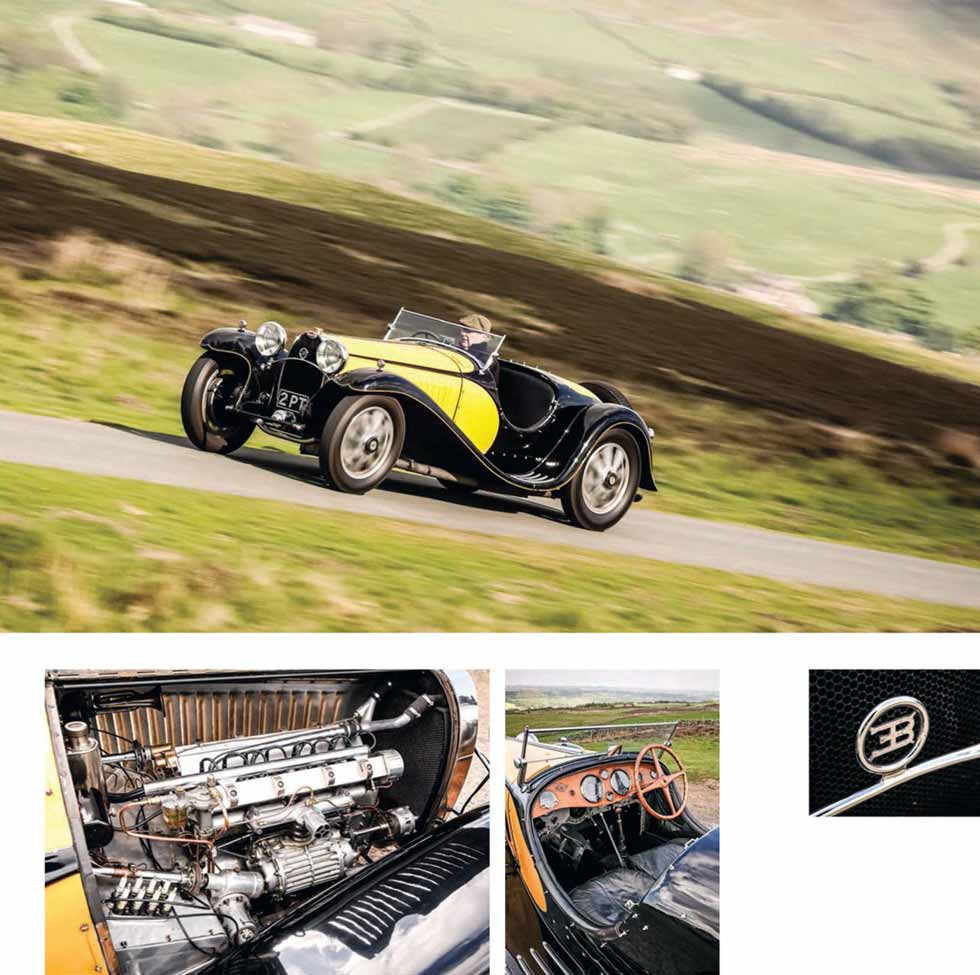
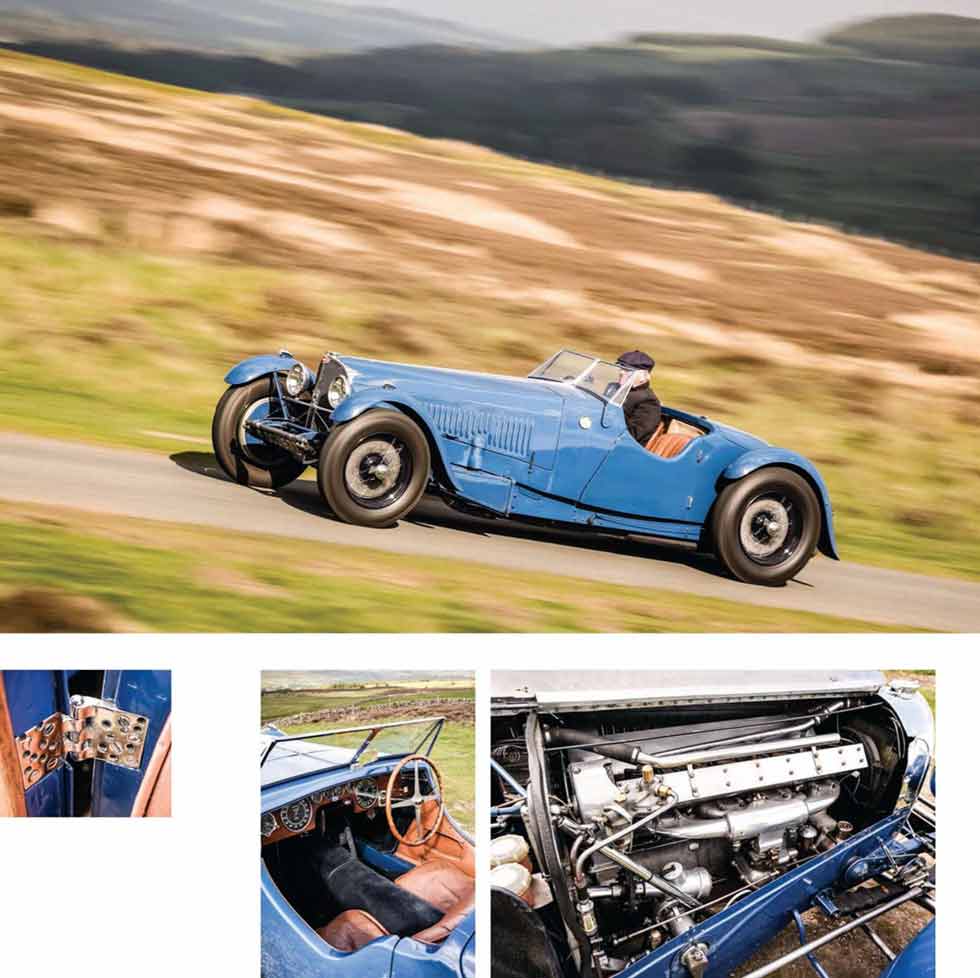
NEIL CORNER: TAKING ON RACING GREATS
Few have experienced such a wealth of superb cars as this Durham-born enthusiast. From gunning a GT40 flat-out at Montlhéry in the 1967 1000kms to harnessing a 600bhp Mercedes-Benz W125 titan around tight Monaco streets, during his 26 years of motorsport Corner raced the greatest. Bugattis have been a constant feature of his collection, including the rapid Type 35 ‘4965,’ and the fabulous ex-Earl Howe Type 59 ‘59123’, which he last drove to victory in the VSCC’s all-Bugatti race at Silverstone in 1986.
An appreciation of fine engineering started with his father, a successful AJS motorcycle racer. Discouraged from riding quick ’bikes, Corner’s long line of road cars began with a tired MG TD, followed quickly by an Austin-Healey 100M, which developed his car control. Over the decades, a fantastic variety of machines has entertained locals on his 96-mile commute across North Yorkshire, ranging from veteran Mercedes to a 1964 Ferrari 250GTO.
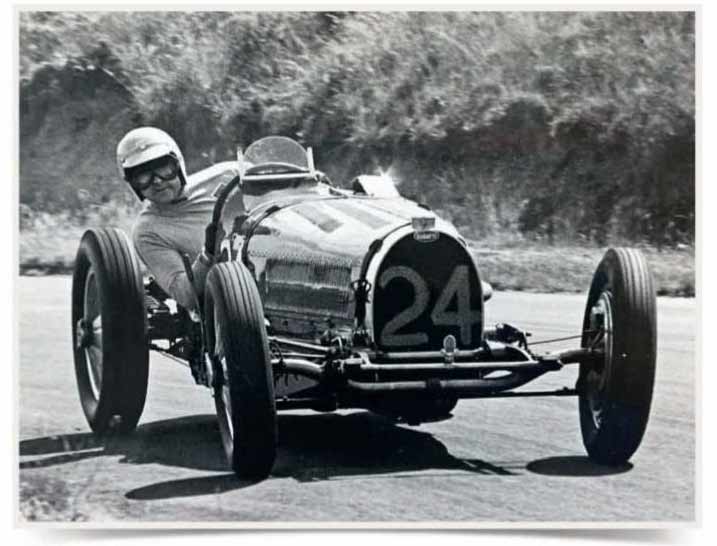
Today, the two Bugattis keep impressive company in the Corner motor house with the fastest pre-war Bentley, an amazingly original Maserati 250F and a pair of Jaguar E-types.






